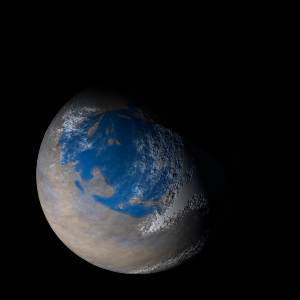|
|
Space Astro
|
Info for exoplanet "Chuukya Bo"
| Scientific (actual) data |
|---|
| Name | Kepler-1337 b |
| Planet status | Confirmed |
| Radius | 0.215 |
| Orbital period | 24.4003 |
| Discovered | 2016 |
| Updated | 2021-02-05 |
| Tconj | 2454970 |
| Publication | Announced on a website |
| Detection type | Primary Transit |
| Alternate names | 2MASS J19080218+4647459 b, K02751.01, KIC 9881077 b, KOI-2751 b, KOI-2751.01, WISE J190802.18+464746.0 b |
| Star name | Kepler-1337 |
| Right ascension | 287.01° |
| Declination | 46.8° |
| Mag j | 14.095 |
| Mag h | 13.497 |
| Mag k | 13.294 |
| Star distance | 588 |
| Star metallicity | -0.09 |
| Star mass | 0.7 |
| Star radius | 0.67 |
| Star age | 4.27 |
| Star temperature | 4523 |
| Star alternate names | 2MASS J19080218+4647459, KIC 9881077, KOI-2751, WISE J190802.18+464746.0 |
| Wikipedia article | Kepler-1337 b |
Back
| |
| Fictional info (?) |
|---|
| Suggested name | Chuukya Bo |
| Planet type | Cold planet |
| The largest moon, Pubugosha Woze, has a diameter greater than that of the planet Jupiter.
The largest moon is crowded with strange primitive carnivores, the "Haneka Na", that survive in caves by hunting something called Shutehe. Most of them are somewhat related to the Rohyo-guhenyu and have wings and vary in length from 50 to 80 meters. They are able to survive temperatures from -50 to 0°C and to some degree very low gravity. |
| Estimated population | 500000000 |
| Atmosphere | Water | 70% |
| Methane | 26% |
| Oxygen | 3.2% |
| Carbon dioxide | 0.18% |
| Atmospheric pressure | 28 bar |
 |
| Moon | Hagowamu | Small potato shaped gaseous comet |
| Zesho | Huge slightly egg-shaped oceanic asteroid |
| Pubugosha Woze | Small potato shaped crater-filled planetoid |
| Akuukyu Hyopya | Large almost round crater-filled moon |
| Chopo | Small slightly egg-shaped oceanic moon |
| Nyocho Sha | Very small slightly egg-shaped gaseous comet |
| Maamya Sobu Pa | Medium-sized round oceanic moon |
| Biwokou | Very small round rocky planetoid |
| Kupena Gipyu | Medium-sized irregular crater-filled moon |
| Wobyu-nyu | Medium-sized round gaseous asteroid |
| Chazu Po | Very small round ice moon |
| Munebiju | Medium-sized round ice planetoid |
| Poepyane Myu | Small potato shaped crater-filled moon |
| Gagimi | Large round rocky asteroid |
| Gyupoge | Small irregular oceanic moon |
| Tara Ryaba'da | Large round rocky asteroid |
| Byuryami | Medium-sized potato shaped oceanic comet |
| Google search for Chuukya bo |
|
Website by Joachim Michaelis
|
|
|
|